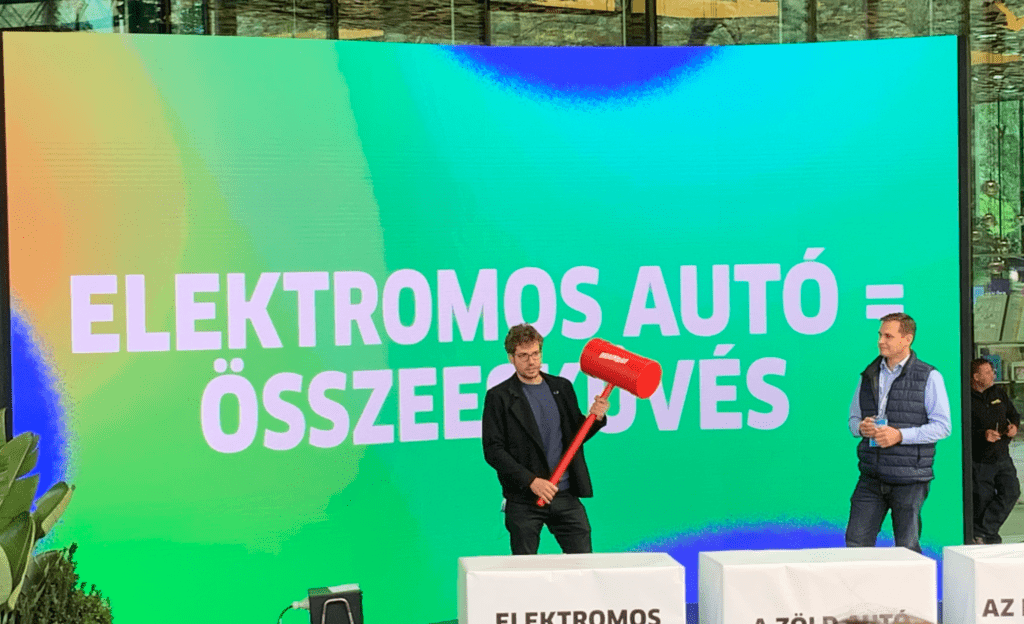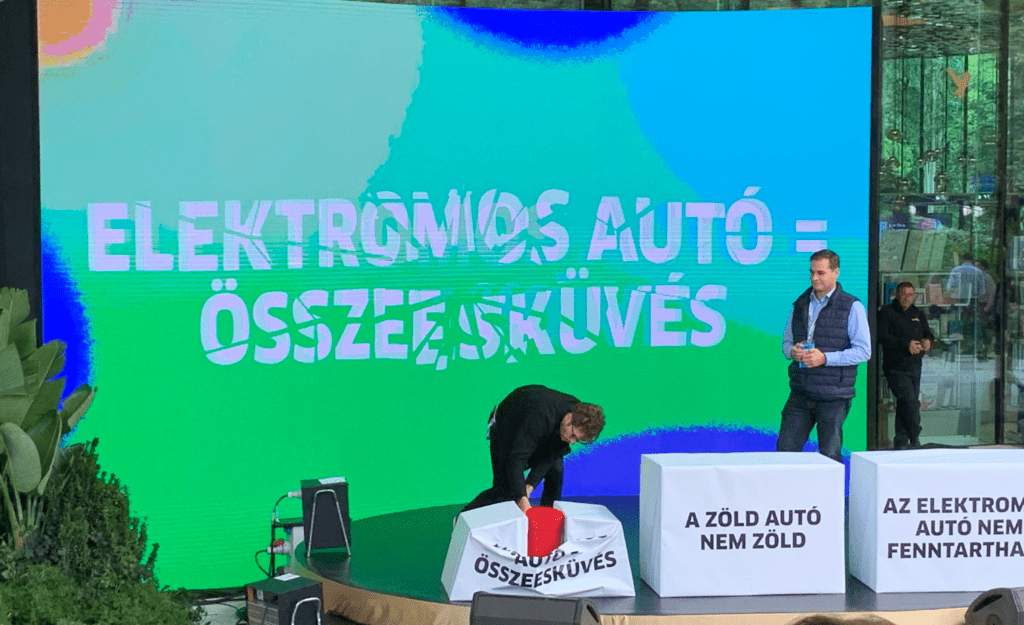As more and more seats filled up despite the drizzling rain, discussion after discussion took place on the Forum Stage, located just outside the House of Music. The following is a short summary of a discussion about whether people should choose electric vehicles, and whether EVs are really as sustainable as most claim. The panel was hosted by Márkó Linczényi, and his guest was Péter Gergen, the Director of E-Mobility Development (Engineering Vehicle Electrification) in Hungary at Bosch Magyarország.
Myth Busting
The idea behind the discussion was unique, as the host prepared three ‘myths’ or statements about electric vehicles. He presented the ideas as someone who approves of them, while Mr Gergen was there to provide counter-arguments and make both Linczényi and those listening rethink their position or, as they put it, ‘bust the myths’. The spectators were given different kinds of objects to express their agreement with loud sounds after a myth was presented or even busted, while the host had a large red hammer on stage which he used to literally bust the paper boxes representing the presented ideas. The first myth presented was that electric cars are a conspiracy.
If e-mobility is the future, why is it still so expensive?
To be fair, electric vehicles are not a newly invented technology. In the 1800’s, electric engines were already used, in fact there were more on the roads than combustion engines. However, after Robert Bosch invented the automatic starter, combustion engines became much easier to use, thus the manufacturers and consumers switched to those. At this moment in time, there is a renaissance of electric cars. It is not a conspiracy; humanity is going through a conscious process of forming their future. We started to think about what is going to happen to the Earth if we persist with our past practices. I have been working for five years at Bosch on developing electric vehicles. Our main goal and focus currently is affordability.
Is this not purely marketing? Or as they say ‘greenwashing’?
At Bosch, we do not think that everyone should switch to ‘green’ vehicles, in fact we are of the opinion that parallel to electric cars, we will need combustion engines in the future as well. One has to consider that even if all carmakers started to produce electric automobiles at this point, it would take about 30-35 years for them to switch all their existing cars to electric. This is a utopistic scenario, which cannot and should not be realised, as it is not worth switching over completely. There are some areas in the industry where electric engines would simply not serve the purpose as well as combustions.
Should I sell my old car? I mean it is already manufactured, its carbon footprint has happened, wouldn’t it be more sustainable for the environment if I kept it?
EU regulations are forcing manufacturers to only release vehicles with electric drivetrains from 2035. However, it is important to mention that the current modern cars matching the EU6 regulation are environmentally friendly, far less polluting than those manufactured before. The exhaust fumes coming from a modern car are simply not comparable to an older one.
My car is already rusty, and my mechanic fixes everything with old, used car parts. How is he going to be able to fix my electric one if I switch?
The novelty about electric vehicles is the electric drivetrain. To put it simply, he will have to learn something new. These batteries are high voltage compared to the ones in regular cars, so he will need to be careful, and study a bit about how such voltages need to be handled. Regardless, there already are courses that teach how to handle electric drivetrains and these batteries. Your mechanic simply needs to attend them and learn new things, adapt to change.

This statement concluded questions about the first myth, which both the host and the audience agreed has been busted by Mr Gergen. Linczényi then picked up his red hammer and smashed the box stating that electric vehicles are a conspiracy. The next myth on the table was ‘green vehicles are not actually green’.
Driving around in Budapest, one sees an electric SUV weighing multiple tons, taking up two separate parking spaces. How can such a huge car be produced with a low carbon footprint?
According to a study conducted by Yale University, the manufacturing of electric vehicles already leaves a smaller carbon footprint than that of regular cars. There are two main reasons for this. One is that electric cars require far fewer parts than those that are propelled by combustion engines. These parts can be produced in-house by the manufacturers themselves, and since there are significantly fewer of them, their shipping and transporting creates a lesser carbon footprint. Another factor to consider is the long-term sustainability of electric cars. As more and more EVs hit the road, the generation of green energy becomes gradually more advanced. Utilising renewable sources to charge electric vehicles is already a rapidly growing industry, and it will only continue to prosper. Thus, as time goes by, the carbon footprint of electric vehicles is going to be smaller and smaller, as the technology behind it becomes more and more advanced. The footprint of such vehicles is defined by the way they are charged, so, as the technology gets greener, the cars do as well.
My phone battery is already struggling, I have to buy a new one every year at this point. Wouldn’t the same happen to the battery of my electric car?
The first factor to consider is the lifetime of these batteries, a car and phone battery are completely different. I will tell a story to illustrate my point. At the company where I work there are hundreds of engineers working on electric vehicles. Some of them like to experiment. One of them bought two identical phones, one for himself, one for his wife. The goal of the experiment was to prove that battery life depends on how they are used. On the wife’s phone there was a case—so the battery could cool down a lot more slowly—and it was almost always left on the charger, even when it was necessary. There was no case on his phone and he only charged it when it was absolutely necessary. After merely a year, the battery life of the phone of the wife was at 89 per cent, while his still had 100 per cent. Keeping this in mind, the battery in an electric car is well managed. It is cooled and heated as necessary; one could say they are pampered by the cars. Keeping the optimal circumstances for a battery guarantees its long lifetime. However, even if the battery life starts to drop, they reach their ‘second life’. These batteries are perfectly utilised as energy storage. Battery farms are installed all over the world now, as they are able to store excess energy that one produces with renewable sources. If they reach a point where they cannot be utilised as energy storage anymore—we are talking about 15 to 20 years here—then they can be recycled. It is a misconception that because of the battery acid and the metals used they are unrecyclable waste. An EV battery can be recycled with a 95 per cent efficiency.
There are rare metals in batteries that are non-renewable on planet Earth. Won’t we simply run out of them if we keep making batteries?
At our company only there are over 400 engineers working on this problem. The key is innovation. In ten years, we will know significantly more than we do now. The simulations and calculations regarding these parts are not even comparable in speed and accuracy to those we had twenty years ago. As I mentioned before about charging, as time goes by, technology only gets better—we will have options. However, the issue is not really about rare metals used in batteries, its more about magnets used in electric engines. This is currently not sustainable. There is a finite quantity of magnets on the planet. They are widely used in the tech industry—mobile phones also utilise them. The smaller and stronger an electric engine is, the more magnets are required to manufacture it. If the production of electric cars continues at this rate, we will simply run out of magnets. Our main goal at Bosch is to find an alternative that is renewable. I must say, we are on the right path. There are a number of Hungarian ideas for innovation that could hit the market in about 4–5 years. This means that the future of electric cars could be paved with Hungarian engines.

This concluded and busted the second myth. The red hammer struck on the cardboard box once again. The next idea was that ‘electric cars are not sustainable’.
I can drive down to the Balaton, but I cannot drive back because I need to charge my car. It doesn’t seem to be worth the trouble.
There are different points of view to consider when talking about this issue. First is of course charging. Most electric cars have the capacity to reach Lake Balaton. Once one arrives, they can charge their cars and drive back with a full battery. In addition, the infrastructure and the speed of chargers throughout the world and our country is rapidly improving. By 2030, in my opinion, we will reach an average of 700 kilometres of driving distance with one charge. The most important factor is efficiency. While a combustion engine effectively uses about 40 per cent of the fuel put into it, a current electric motor utilises 84 per cent. The goal is to improve these numbers and push the average over 90 per cent. Since there is an energy and fuel crisis, this is becoming more and more important. To use a practical example: one puts 100kw/h of electricity into their car. 90kw/h is used to propel the car, and the rest for heating the car, or simply put, is the calculated loss. If one calculates the same with gas, of 100 litres the car only utilises 40 for moving, and the rest is used for everything else, or is lost.
Obviously, electric engines do not pollute locally, however, they need to be manufactured.
The main idea to consider is reaching a healthy energy mix in a country. If one only uses coal-based power plants and charges electric vehicles with that energy, that is not sustainable. Countries need to improve their infrastructure of renewable energy sources such as solar, wind and even nuclear.
So, the cars are sustainable, but the production of energy isn’t?
I would not say that production is necessarily unsustainable. We need to consider how much they cost and what can we do to make sustainable sources spread more throughout the world.
Regarding the energy crisis, electricity costs twice as much as it used to. Are we paying twice as much to charge cars? What guarantees are there that it won’t get more expensive?
Unfortunately, there are no such guarantees. We live in difficult and unique times currently. The situation is volatile, however, in my opinion, in the long run things will go back to normal. Of course, prices are at a maximum right now, but even so it is cheaper to maintain and fuel an electric car than one with a combustion engine if we look at a 100-kilometre range.
The infrastructure of Budapest could not handle everyone switching to electric. Even if there were enough chargers, would there be enough energy to charge all those EVs?
We need to change our routines. We cannot expect the city to be filled with chargers where one can fuel their cars in five minutes and go on their merry way. These do exist, but they should only be used on a highway. During the night, one can charge their cars at home, as almost all of these cars can be charged from a simple socket in a household. A good incentive is to put such wall sockets around the city next to parking spots. By doing that, one can stop at a given place to run their errands, plug their car into the socket while they are inside, and by the time they come out the battery will have received enough charge to continue to the next destination. As far as I know, authorities are already working on installing these sockets. To answer the other question, of course, if everyone started charging electric cars, there would not be enough energy. Therefore, we need sustainable power plants. Hungary is on the right track with solar and nuclear power already. Also, Europe is connected in their power production. This means that if Hungary used more power than it could create, they could import it from another country. For example, nuclear energy from France. If everyone switches to electric, we will obviously need to improve the electric grid, but everyone will not switch, at least not in the next 40 or 50 years, so we have a long time to figure out and implement changes like that.
After the third myth was successfully busted, the discussion ended, with the audience taking home plenty of exciting insights.








